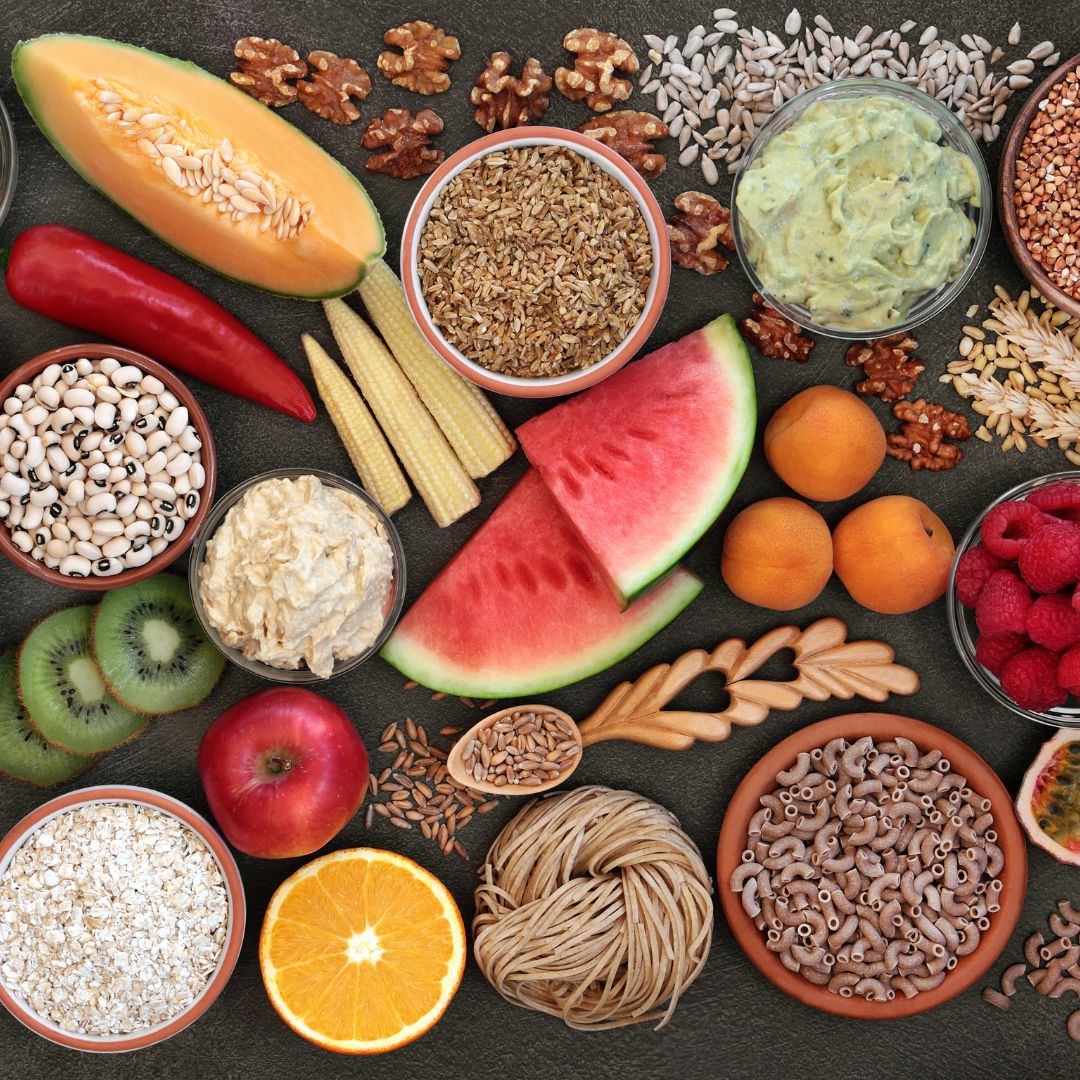
Spotlight on IBS
Irritable Bowel Syndrome is a problem I see so often in clinic, and it is problematic on many different levels. If you have been diagnosed with this condition, you may well have been suffering with it for years and, while a diagnosis can – at first– offer comfort in finally having a recognised problem, the satisfaction is short lived because often that’s where all support ends, and you’re left no further forward in actually fixing what the problem is.
The difficulty begins because IBS is essentially meaningless; it’s a catch-all term used to encompass a huge variety of digestive issues. If you’re serious about getting to the bottom of the problem (no pun intended), I’m happy to discuss your symptoms and help find a way forward. You can book a free IBS health check with me by clicking here.
In my experience, it’s likely to be one of the following five conditions.
1 SIBO (small intestine bacterial overgrowth)
Around 60% of people with IBS will have SIBO. Though you might have heard about good (and bad) bacteria in the gut, really what experts are talking about is the balance of bacteria in the large intestine: the colon.
The small intestine shouldn’t have any bacteria, and each day the body should perform a flush to sweep bacteria from the small intestine and into the large intestine. This flush is called the ‘migrating motor complex’. For a huge variety of reasons (historic food poisoning being the most common, but also low levels of stomach acid or adhesions play a role, among others) the bacteria are not swept away.
The trouble is that these bacteria can ferment the food in your small intestine, causing gas, belching, bloating, pain and a variety of other symptoms, including constipation and/or loose stools, and even anxiety. A breath test can establish which gases are present, and we can devise an action plan based on your results.
2 Lactose intolerance
This is when your body is not able to tolerate lactose, a type of sugar found naturally in milk and other dairy products. Essentially, bacteria in your intestine feed on these milk sugars, leading to a host of IBS symptoms, like bloating and gas, nausea, constipation or diarrhoea.
It can go hand in hand with other digestive complaints, such as coeliac disease or increased intestinal permeability (‘leaky gut’). Lactose intolerance can be diagnosed via a simple at-home breath test.
3 Fructose malabsorption
The symptoms are very similar to lactose intolerance. Fructose (which is found in fruit, honey and many processed foods) is a sugar, which, like lactose, is digested in the small intestine.
Some people cannot absorb fructose, and what is not absorbed is fermented by intestinal bacteria, causing bloating, cramping, gas and distension of the stomach. You might also experience brain fog and headaches. A breath test will diagnose the condition.
4 Dysbiosis
This is an imbalance in the levels of beneficial (good) and pathogenic (bad) bacteria in the large intestine or colon.
This is now common due to overuse of antibiotics and alcohol, an increase in high sugar diets, and stress.
Symptoms can vary from a sluggish bowel or diarrhoea, pain, bloating and flatulence, to chronic bad breath, joint pain, fatigue and food sensitivities.
Dysbiosis is also implicated in a variety of health conditions like diabetes, heart disease and obesity. A stool test can help establish whether your gut bacteria are out of balance, along with a host of other markers that might be useful in getting to the root of your digestive problems.
5 Yeast overgrowth
Where the gut environment becomes out of balance (due to dysbiosis), yeast can thrive. Diets high in sugar feed the yeast – although if you think you might have a yeast overgrowth, it’s worth noting that long-term yeast problems can mean that the yeast cells are pathogenic or disease causing, and that the yeast has switched its metabolism to also be able to digest protein and fat.
Symptoms of yeast overgrowth include recurring thrush, gas or bloating, fatigue, bad breath, cravings for sweet foods, joint pain and brain fog.
A stool test can establish the presence of candida or other yeast overgrowth.
Some people struggle with digestive problems for years. If you are ready to make fixing your gut health a priority, I would love to work with you. Please click the link here to book your free IBS health check now.

Superboost Sesame Salad
A quick and easy fibre-filled salad just perfect for weekday lunches, and perfect for feeding your friendly bacteria!
Serves 2
Ingredients:
1 x 400g can of chickpeas, rinsed and drained
2 celery sticks, finely chopped
6 pieces of marinated artichoke hearts, roughly chopped
6 spring onions, finely chopped
1 tbsp sesame seeds
1 tsp toasted sesame oil
½ lemon, juiced
¼ bag watercress
¼ bag baby leaf spinach
Handful of basil leaves
Extra virgin olive oil, to drizzle
Extra lemon to serve
Method:

How to improve the health of your microbiome
While there are a number of factors that can contribute to your microbiome, such as your environment, infections or illnesses, food poisoning exercise, diet is one of the most powerful factors. Here are some foods which are really good for supporting your microbiome:
FIBRE
Fibre is one of the best things to eat to support healthy digestion. Fibre is described as either insoluble or soluble.
Insoluble fibre is part of the plant wall in fruit and veg. It’s indigestible so it passes right through your system, sweeping up toxins and other waste products as it goes, and keeping you regular. The undigested fibre is also fermented by gut bacteria, producing the beneficial short chain fatty acids I mentioned earlier.
You can find insoluble fibre in:
· Fruit and veg
· Beans and lentils
· Oats
· Wholegrain foods like brown rice and wheat
Soluble fibre can be partially digested and is well-celebrated for its ability to reduce cholesterol in the blood and normalise blood sugar levels.
You can find soluble fibre in:
· Oats
· Veg
· Fruit (especially apples, pears, berries and citrus fruits)
· Beans and lentils
FERMENTED FOODS
Fermented foods have a long tradition in some parts of the world, especially Asia, Africa and Eastern Europe. Bacteria (and sometimes beneficial yeasts) might be involved in the process and the result is an increase of good bacteria in the foods.
You’ve probably heard of live or ‘bio’ yoghurt. Some of these other probiotic foods might sound peculiar and a little ‘advanced’ for most regular people. However, they are now commonly found on supermarket shelves (you’ll find them in the world foods aisle where the Oriental products are) and, while they might not be the kind of product you would usually go for, it is always worth experimenting.
Kimchi, in particular, is often combined with chilli and other flavours and is far tastier than its name might suggest.
• Yoghurt
• Pickles (gherkins)
• Sauerkraut
• Kimchi (fermented cabbage)
• Tempeh (fermented soya beans)
• Natto (fermented soya beans)
• Miso soup (fermented soya beans)
• Tamari soy sauce.
• Buttermilk
• Some cheeses like cottage cheese, gouda, mozzarella & cheddar.
Fermented drinks
Like other fermented products, these were once only found in health food shops and were perhaps the prevail of people who ate a very clean and unprocessed diet. These were a secret waiting for the masses to discover. Often flavoured with fruits, they really are delicious and do not taste ‘worthy’. You’ll find them in the chilled drinks section in most supermarkets.
• Kombucha (fermented tea – sweet and fizzy but without sugar)
• Kefir (fermented dairy drink very much like a yoghurt drink).
The only way you’ll know if it’s for you is to try!
CRUCIFEROUS VEGETABLES
These smelly veg bring amazing health benefits on a number of different levels. Since we’re talking about foods that are helpful for your digestion, you should know that they contain compounds called glucosinolates, which are fermented by bacteria and used as fuel. They are prebiotic.
Examples are:
Bok choy
Broccoli
Brussels sprouts
Cabbage
Cauliflower
Kale
Rocket
Spring greens
Watercress
ANTI-MICROBIAL FOODS
Some foods exert a natural antibiotic or anti-fungal effect and can be useful for keeping nasties like pathogenic bacteria or unwelcome yeasts at bay.
These include caprylic acid found in coconut. Coconut oil is also a very good oil to use in cooking, especially at high temperatures.
Garlic contains the ingredient allicin, which has historically proven itself to be an effective killer of both bacteria and viruses, making it a great immune-boosting ingredient. Use it raw wherever possible.
Olive oil – the oleic acid has anti-bacterial properties. Use it generously to dress salads and veg.
WHAT TO AVOID
In the same way there are things your digestive system loves, there are things it will not love you for.
Sugar. That’s the number one thing to avoid, plus anything that contains added sugar.
Other things your tummy is not fond of include highly refined products like white rice, pasta, pastry and snacks like crisps and biscuits.
And if you'd like to know further, why not book a free call? You can book in here.

The “Microbiome” - Master Controller of your Health
Do you ever stop to think about the bustling community inside you, one that plays a vital role in your health and wellbeing? I'm not talking about a trendy neighbourhood or a bustling city. I'm referring to your microbiome – the busy metropolis of microorganisms that call your body home sweet home. Unless you have digestive problems, you probably don’t normally give this a second’s thought - but you should.
The “microbiome” is the guardian of your health, and your gut environment could be the reason you have anxiety or low mood, painful periods, terrible menopause symptoms, or difficulty losing weight.
What is the microbiome?
Think of it as your very own ecosystem, but on a microscopic scale. It's made up of trillions of bacteria, viruses, fungi, and other microscopic critters that live in various parts of your body, from your gut to your skin and everything in between.
You might be thinking, "bacteria? That doesn't sound healthy’. Although we used to hearing about bacteria as the bad guys, not all bacteria are bad. In fact, many of them are crucial for keeping you in good health. They help with digestion (of course), support your immune system, and even play a role in regulating your mood, hunger levels, sleep, stress and hormones.
That’s because what happens in the gut doesn’t stay in the gut.
The microbiome and mental health
There is a constant two-way communication with your brain and your digestive system. In my world, we call it the gut-brain axis. It’s been the subject of a lot of research in the last decade and there is increasing evidence that your gut bacteria heavily influence your mood.
Your gut bacteria make chemicals that affect your brain. They produce neurotransmitters, chemical messengers that help transmit signals in the brain. One of these neurotransmitters is serotonin, often referred to as the "happy hormone" because it plays a crucial role in regulating mood and emotions.
A whopping 90% of your body's serotonin is produced in your gut. The balance of bacteria in your gut can directly impact your serotonin levels, and subsequently, your mood. When you have a healthy and diverse microbiome, it's like having a team of cheerful little helpers churning out serotonin to keep your spirits high.
But here's where it gets interesting: your brain can speed up your gut (very simply, how quickly food moves through your body) and change what microbes are present.
And when your gut bacteria are out of whack, it can throw this delicate balance off-kilter. Imbalances in the microbiome have been linked to conditions like depression and anxiety.
The microbiome and immunity
If you’re the kind of person who catches every bug going, consider this might be down to what’s happening in your gut. The microbiome and your immune system are heavily linked.
Imagine your immune system as your body's very own security team, constantly on the lookout for intruders and ready to spring into action at a moment's notice. The microbiome plays a crucial role in training and coordinating this defence force.
The bacteria are like the teachers in an elite military academy, helping to educate and train your immune cells to distinguish between friend and foe. Your gut bacteria also produce molecules called metabolites, which act as messengers in the intricate dance between your microbiome and your immune system. These metabolites help regulate the activity of your immune cells, ensuring they respond appropriately to threats without going overboard and causing inflammation.
Inflammation is a bit like setting off a fire alarm – it's a necessary response to danger, but too much of it can cause chaos and damage. Luckily, your gut bacteria are there to keep things in check, helping to maintain a delicate balance between fighting off invaders and keeping the peace within your body.
But the relationship between your microbiome and your immune system is a two-way street. Your immune system also plays a crucial role in shaping the composition of your microbiome, keeping the peace by promoting the growth of beneficial bacteria and keeping harmful bacteria in check.
The microbiome and your hormones
Your gut bacteria aren't just masters of digestion and immunity; they also have a hand in regulating your hormones. One of the key players is cortisol, often referred to as the "stress hormone".
When you're feeling stressed out, your body releases cortisol to help you cope with the situation. Your gut bacteria can influence the production and regulation of cortisol, potentially shaping how your body responds to stress.
Certain types of gut bacteria can affect the HPA (hypothalamic-pituitary-adrenal) axis, a complex network of hormones involved in the stress response. By producing metabolites that interact with this system, your gut bacteria can influence the production and regulation of cortisol, potentially impacting how your body responds to stressors.
But that's not all – your gut bacteria can also influence other hormones, like insulin, which plays a crucial role in regulating blood sugar levels. Studies have shown that imbalances in the microbiome can lead to insulin resistance, a condition where your cells become less responsive to insulin, potentially leading to high blood sugar levels and type 2 diabetes.
The microbiome and female hormone health
One of the hormones especially affected by gut health is oestrogen, one of the main female hormones. In fact, there is a collection of specialised bacteria in the microbiome called the “oestrobolome”. The oestrobolome contains, among other things, the bacteria responsible for breaking down and eliminating hormones, principally oestrogen.
In short, the microbiome plays a key role in oestrogen metabolism, so an imbalance in healthy bacteria can result in too much or too little circulating oestrogen, which can lead to an imbalance between oestrogen and other hormones. This can have a knock-on effect on your weight, sex drive and your mood.
For healthy oestrogen levels, you want optimal levels of an enzyme called beta-glucuronidase. If levels of this enzyme are too high, oestrogen that might have been marked for excretion gets reactivated, potentially leading to too much oestrogen in relation to other hormones (unopposed oestrogen or oestrogen dominance). This can create a range of problems ranging from PMS, infertility, obesity and metabolic syndrome, and oestrogen-related cancers.
The microbiome and your skin
Your skin is your body's largest organ and serves as a vital barrier between you and the outside world. And just like your gut, your skin is home to a bustling community of bacteria, fungi, and other microorganisms that make up your skin microbiome.
Again, bacteria on your skin might sound like a recipe for disaster but the vast majority of these microbes are harmless or even beneficial, playing essential roles in maintaining healthy skin.
One of the skin microbiome's primary functions is to act as a barrier against harmful pathogens, preventing them from invading your body and causing infections. When your skin microbiome is in balance, it helps keep your skin healthy and resilient, warding off pesky invaders like bacteria, viruses, and fungi.
Your skin microbiome isn't just a passive bystander; it actively interacts with your immune system, helping to educate and train immune cells to distinguish between friend and foe. Studies have shown that imbalances in the skin microbiome can lead to inflammatory skin conditions like acne, eczema, and psoriasis, suggesting that maintaining a diverse and balanced microbiome is crucial for healthy skin.
When the microbiome misbehaves
Any disruption to the microbiome may result in an imbalance in the microbiota leading to ‘dysbiosis’. Dysbiosis means:
When your gut health gets imbalanced and dysbiosis happens, you’re more likely to have stomach and other health issues. These conditions can include:
Typical symptoms of dysbiosis include:
Testing can be invaluable in finding out what is happening with your microbiome. A comprehensive stool test can map out your microbiome, detailing friendly bacteria, and potentially pathogenic bacteria, funguses or parasites. If you’d like to know more, why not get in touch? Just book a link here.

Your Hormone Balancing Action Plan
If you’re suffering with PMS, menopausal symptoms, or hormonal conditions such as PCOS and endometriosis, then take a look at this plan. These simple changes aren’t going to solve everything, but if made consistently over time, they can have a positive effect on your mood and how you feel.
Here’s where to start:
Eat Real Foods
If your hormones are out of whack or you struggle with anything to do with your mood, the very first thing to do is to take a good look at your diet and consider how much ‘real food’ you eat and how much of your diet is processed. If you ONLY switched to real food, making everything from scratch, you would see a big improvement in your health. Ready to do more?
Bring in more fruit and vegetables
Fruit and vegetables are packed full of nutrients compared to many other foods and are beneficial for all aspects of health. Focus on the low-sugar fruits (the ones that grow in this country ahead of tropical fruits like bananas, mango and pineapple). For veg, eat more of the stuff that grows above the ground as – as a general rule – it contains less starch and keeps blood sugar levels stable.
Eat protein regularly
Choose a source of protein at every meal and snack. Protein is needed for growth and repair in the body. Good sources of protein include eggs, organic meat and poultry, oily fish like wild salmon, trout, etc. and Greek yoghurt, nuts and seeds.
Think carefully about starchy carbohydrates
Carbohydrates can be broken down into simple carbs and complex carbs. In simple carbs, the sugar molecules that occur either naturally or as a result of added sugar are quickly digested and absorbed into the bloodstream. Examples of simple carbs are cakes, cookies and pastries (in fact, anything with sugar), white bread, rice and pasta, and potato. The result is you get a short-term high but afterwards you feel more tired, fuzzy-headed and hungry.
Complex carbs are made up of hundreds of sugar molecules, and these are absorbed much more slowly so they keep you feeling fuller and focussed for longer. Focus on bringing more of these into your diet ahead of simple carbs. They include wholemeal bread and pasta, brown rice, oats, beans, chickpeas and lentils, quinoa, sweet potato and butternut squash.
Do eat fat
Healthy fats are an essential part of a good diet and should not be seen as the enemy. Fats are also the building blocks of all hormones and keep cell membranes and nerve cells healthy. The best sources of fat are flaxseeds (also known as linseeds), avocado, olive oil, coconut oil, oily fish like wild salmon, nuts and seeds.
Prioritise sleep
There are some actions you can take to make a good sleep much more likely. These include things like avoiding drinks containing caffeine after lunch, going to bed at the same time every day, keeping the temperature in your bedroom comfortable, keeping the bedroom completely dark so you’re not disturbed by light and making an effort to relax for at least 5 minutes before going to bed - a warm bath, massage, meditation and so on.
The biggest tip I can give you is to really ensure that you prioritise your sleep. Make a real effort to focus on all the things you can do to improve your sleep hygiene rather than ‘kind of’ doing it.
Move your body
Exercise can have a noticeable effect on hormones and mood. You might have heard how exercise releases endorphins and the feel-good hormones dopamine and serotonin.
Instead of moving in such a way that you place excessive stress on the body, consider how your body likes to move. Focus on things like brisk walks, yoga or pilates, and dance classes ahead of more punishing regimes involving spin classes and long runs.
Improve your digestive health
There might seem quite a geographical distance between your digestive system and your brain but the two are actually very closely connected. In fact, the digestive system is often referred to as the ‘second brain’. If you have any problems with your digestive system, it will be worth working on these with a nutrition professional. Your coach will be able to advise if any functional testing might be appropriate to look for food reactions (allergies or intolerances) or a broader test to see whether you might have bacterial imbalance or infection.
For the purposes of this guide, it might be helpful to ensure you regularly eat probiotic foods like natural yoghurt, kefir and kombucha (all are now widely available even in supermarkets) or even take a probiotic supplement.
Reduce stress
Taking action to reduce stress in your life is essential but many people are concerned the specific things they might do are too much of a luxury in their already-busy lives. Bottom line: you can’t simply keep going the way things are. Taking some time to empty the ‘stress bucket’ is critical for your wellbeing. Yoga and mindfulness/meditation are proven ways to reduce stress but consider taking time out just to do the things you love to do quietly, mindfully and on your own: sitting in the garden with a cuppa, reading, colouring, knitting or trying out a new hobby.
Get expert help
If you’re unsure where to start, why not get in touch? I offer free 30 minute calls, and just might be able to help you.

Ever feel like the weight of the world is a little lighter after a chat with a friend or a shared laugh with a group? It's not in your head. Science shows that community and connection are powerful ingredients in the recipe for better health - and they might just be the missing piece of your wellbeing puzzle.
We're wired for connection. Humans are social creatures, and our health depends on it. Studies have shown that people with strong social ties live longer, have better immune systems and even recover faster from illness. On the flip side, loneliness is as harmful to your health as smoking 15 cigarettes per day. Yes, really - click here to find out more.
Take Okinawa, Japan, where people form moais, small groups of friends who commit to supporting each other for life. Or Sardinia, Italy, where communal meals and shared celebrations are part of daily life.
What makes these communities special isn't a secret. They've simply made connection a priority. And that connection, whether through friends, family, or shared purpose, creates a ripple effect: better habits, stronger resilience, and a greater sense of belonging.
Let's be honest: making changes to your diet, exercise, or lifestyle isn't always easy. But when you are part of a supportive community, it's a whole lot easier to stay on track. Surrounding yourself with people who share your goals - whether it's eating better, moving more, or just being kinder to yourself - can inspire you to achieve more than you thought possible. This is one of the reasons Facebook groups - despite all the politics - are thriving.
Eating habits: Sharing healthy recipes or cooking with friends makes good nutrition feel fun and sustainable
Exercise motivation: Joining a walking group or fitness class keeps you moving (and accountable)
Emotionals support: A quick chat with someone who 'gets it' can help you power through those tough days
We tend to reflect the behaviours of those around us. So, finding a community that supports your goals isn't just nice - it's smart.
Connection isn't just about shared goals. It's about feeling seen, valued, and part of something bigger than yourself. That sense of belonging can lower stress, boost happiness, and even reduce inflammation in the body. It's the ultimate mind-body benefit.
Whether it's a group of close friends, a local community group, or even an online space where you feel at home, belonging feeds your soul and your health.
Community comes in all shapes and sizes, and finding the right fit for your personality, lifestyle, and goals is key. Here are some examples of thriving community spaces that can inspire connection and better health:
Health and wellness groups
Fitness classes: local yoga studios, Zumba sessions, or even park boot camps often create a strong sense of camaraderie. Sharing a workout with others can help you stay motivated, even on the days when you'd rather not lace up your trainers.
Why it works: The shared goal of better fitness fosters a positive, supportive environment. You're not just exercising: you're bonding over a shared challenge.
Cooking or nutrition workshops: Whether it's a meal-prep class or a group that meets to share healthy recipes, these spaces offer practical knowledge and social connection.
Why it works: Cooking and eating are inherently social activities, and group settings make them even more enjoyable. You can also swap tips, successes, and even the occasional healthy treat.
Virtual communities
Online forums and groups: Platforms like Facebook groups or community apps (eg Meetup or Nextdoor) allow people with shared interests to connect, regardless of location. For example, a virtual walking club where members log miles and cheer each other on through group chats or video calls.
Why it works: For people with busy schedules, mobility challenges, or who live in rural areas, online communities can offer the same benefits as in-person ones.
Cross-generational opportunities
Volunteering programmes: Community gardesn, charity events, or organisations like Age UK or Lady McAdden's often bring people together of all ages to work on shared projects.
Why it works: Cross-generational activities encourage empathy, expand perspectives, and bring a wealth of new ideas to the table. Plus, they create a sense of purpose.
Mentorship schemes: Whether it's through a professional organisation or a local school, mentorship provides a two- way exchange. The mentee gains knowledge, and the mentor finds fulfilment in giving back
Hobby-based groups
Outdoor clubs: Hiking groups, cycling clubs, or even birdwatching societies combine physical activity with the chance to connect over a shared love of nature.
Why it works: Time outdoors reduces stress, boosts mood, and offers a refreshing change of scene, while the group dynamic keeps you engaged.
Creative meetups: Think knitting circles, book clubs, or art workshops. These are spaces where people come together to create, learn and share.
Why it works: Creativity is a powerful way to relax and focus and doing it with other multiplies the joy and motivation.
Faith-based communities
Many religious and spiritual organisations offer regular gatherings that focus on connection, reflection, and shared purpose.
Why it works: Faith communities often create a strong sense of belonging, which can reduce stress and provide comfort in challenging times.
If you're thinking, "That sounds amazing, but where do I start?", here are some ideas:
Reconnect: Reach out to friends or family members who make you feel good.
Try something new: Join a class or club that sparks your interest.
Find your online tribe: Virtual communities can be just as supportive as in-person ones.
Start small: Even one meaningful connection can make a difference.
It's completely normal to feel unsure or hesitant when it comes to building connection. The important thing is to take that first small step. Whether it's to text an old friend, attending a new class, or simply smiling at someone in passing, every little effort counts. Over timelines those small moments of connection can grow into something bigger - a network of support, joy, and belonging.
So, who will you connect with today?
Who are your biggest cheerleaders?
How often do you connect with them?
What's the one thing you can do this week to nurture those relationships?
![]()
Please get in touch and find out more - I offer a free 30-minute exploratory call.